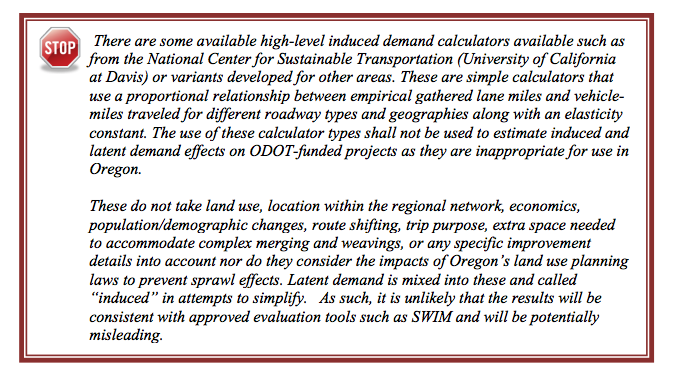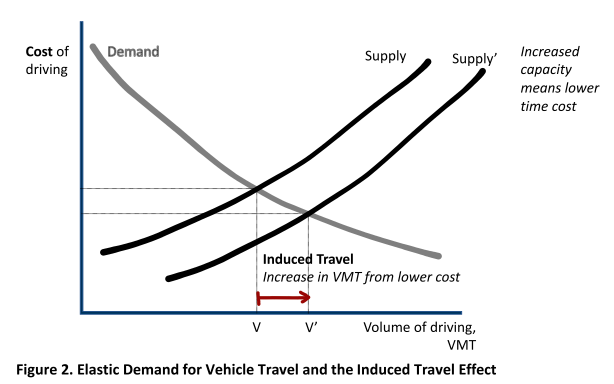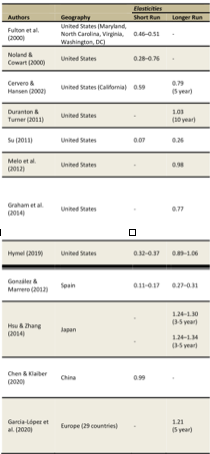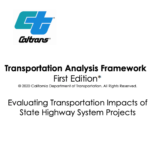The science of induced travel is well proven, but state DOTs are in utter denial
Widening freeways not only fails to reduce congestion, it inevitably results in more vehicle travel and more pollution
The Oregon Department of Transportation has published a technical manual banning the consideration of induced travel in Oregon highway projects.
The Oregon Department of Transportation wants to pretend that induced travel doesn’t exist. Using federal funds, it has written a new handbook on how to plan for highways that makes some preposterous and undocumented claims about the induced travel. It explicitly prohibits planners and consultants from using peer-reviewed, scientifically based tools, like the Induced Travel Calculator, developed by the University of California Sustainable Transportation Center, and mandated by the California Department of Transportation for the analysis of the environmental effects of freeways.
The tortured denial by the Oregon Department of Transportation engages in some blatant sophistry that tries to create a false distinction between “latent” demand and “induced demand.” If we just call it “latent demand” then somehow it doesn’t count.
Turn to page 6-79 of ODOT’s newly published “Analysis Procedures Manual“. The APM is a technical guide to using traffic data to plan future roadways. Here you find a red-bordered text box with a bold graphic STOP sign, explicitly banning planners and analysts from using the induced travel calculator. “The use of these calculator types shall not be used to estimate induced and latent demand effects on ODOT-funded projects . . . ”
This kind of foot-stomping, hand-waving denial is reminiscent of the Catholic church’s harrumphing denials of Copernicus and Galileo’s observations of the universe. But induced travel is extremely well-established science, and Oregon DOT shows itself to be modern day a flat-earth science denier.
What the Scientific Literature Shows
The economic and scientific literature on induced travel is unambiguous: Increasing road capacity, by whatever means, lowers the perceived cost of driving and results in more travel. The phenomenon is now so well-established that its called the “Fundamental Law of Road Congestion.”
The economics are straightforward: expanding the supply of highways lowers the cost of driving, and faced with a lower cost of driving, people drive more. In this classic diagram, the supply curve shifts outward (to the right) lowering the cost of driving and increasing the number of miles driven.
The best available science shows that this generated travel follows a unit elasticity: a one percent increase in roadway capacity creates a one percent increase in vehicle miles traveled. To claim otherwise is to simply be in denial about the fundamental economics of the price elasticity of demand: lowering the price of something (in this case the time cost of using a particular roadway) tends to increase the volume consumed.
There have been numerous studies which have all reached similar conclusions about the empirical nature of this relationship. Two of the leading scholars on the subject, the University of California’s Susan Handy and James Volker present a meta-analysis of studies of induced travel. Their results are summarized on the following table. In studies in the US and in other developed countries, there’s a strong and consistent relationship between expanded roadways and additional travel. In the long run, estimates of the elasticity of induced travel are around 1.0, meaning that a one percent increase in road capacity tends to lead to a one percent increase in vehicle miles traveled.
The authoritative Traffic Engineering Handbook summarizes the literature on induced demand as follows:
. . . the long-run elasticities of VMT with respect to road space is generally 0.5 to 1.0 after controlling for population growth and income, with values of almost 1.0, suggesting that new road space is totally filled by generated traffic where congestion is relatively severe.
Kara Kockelman (2011), “Traffic Congestion,” Chapter 22, Transportation Engineering Handbook, McGraw Hill .
ODOT asserts that it can ignore all this literature. ODOT argues, in essence, that even thought the consensus is for a unit elasticity, that here in Oregon, contra all this published literature, it believes the real coefficient of these equations is zero: that a one percent increase in roadway capacity would lead to no increase whatsoever in travel demand. In essence, the ODOT Analysis Methods Manual tells planners to ignore induced demand entirely.
Latent demand is induced demand.
The apparent justification for this conclusion is that there’s something called “latent” demand that’s different from “induced” demand.
Oregon DOT falsely claims that there is a difference between “latent” demand and “induced” demand. Here’s what they are saying…
Latent Demand – this is demand for transportation that consumers do not utilize because they cannot afford the cost or it is not currently available. Latent demand responses are typically associated with network limitations, such as capacity constraints . . . Latent demand does not include induced demand.
Induced demand – new demand for travel that did not exist prior to the build scenario. This is above and beyond forecasted and latent demand associated with planned land use, it is demand that is the result of changes in land use (zone changes) or economic conditions that create new trips.
(ODOT Analysis Procedures Manual, June 2022, emphasis added).
Denying that “latent” demand is induced demand is not supported in the literature. No other study uses these terms in this fashion, or makes this distinction between “induced” and “latent” demand. This is ODOT’s Through the Looking Glass moment:
“When I use a word,” Humpty Dumpty said, in rather a scornful tone, “it means just what I choose it to mean- neither more nor less.”
Ben and Jerry observe the latent demand for ice cream every year when they drop the price of a cone to zero, and people line up around the block. These are all people who would love to have ice cream, if only it were free. The lines around the block are “induced ice cream eating”, as the zero price of ice cream converts “latent demand” into “actual demand.”
But we know empirically that travel changes rapidly in response to available highway capacity. That’s true both in the case of expansions and contractions in capacity. People rapidly and radically change their travel distances and trip making in response to changes in capacity. Predicted “carmaggedons” in the face of reductions of capacity from bridge closures, highway collapses, construction projects, demolitions of highways, and other similar events cause traffic disappearance.
Ultimately, this is pure sophistry: Whether you call it “latent” demand or “induced” demand, the effects are exactly the same: Adding more capacity to existing roadways increases the volume of vehicle travel.
Oregon’s Analysis Procedures Manual vs. California’s Transportation Analysis Framework
While OregonDOT has just published its “Analysis Procedures Manual” banning the use of induced travel calculators, its California counterpart, Caltrans has published guidelines that require the use of such a calculator to highway projects in the Golden State. What leads one state DOT to require the calculator, while the other bans it. Who is right?
Let’s consider the processes and documentation that went into the CalTrans and ODOT publications. CalTrans adopted its Framework after a years-long study and review effort. It brought in outside experts, it conducted and published a thorough literature review, and the Framework itself was the subject of public meetings. As the Framework document explains:
Caltrans convened an expert panel of academics and practitioners through UC Berkeley Tech Transfer. The panel chair presented the group’s conclusions to stakeholders at a virtual Technical Roundtable prior to finalizing the group’s recommendations. Caltrans and State partners have accepted the panel’s recommendations, which are reflected in the guidance documents.
In contrast, the Oregon Manual has no identified author, cites no academic literature, has not been subject to outside review by persons independent from the Oregon Department of Transportation. It is an unsubstantiated, unscientific polemic.
It’s also possible (and indeed likely) that even without changes in land use, households and businesses will sort themselves differently among the existing stock of land and buildings. If travel is fast and free, people may choose to live at housing a great distance from their jobs (or conversely, commute to jobs at great distance from their homes). If travel is slower or more expensive, they may seek housing nearer their job, or look for jobs only closer to home in order to minimize the time and money costs of travel. The redistribution of population and employment among existing buildings in response to changes in travel costs is something that ODOT denies is even possible.
What’s deeply ironic about the denial of induced demand is that highway departments have been counting on it to create an unending demand for their services for decades. Building more and wider roads has led to more driving and more car ownership, which has jammed existing roads to capacity, and led to calls for further widening. It’s a Sisyphean cycle that leads to ever more traffic and ever more spending on roads, which is just what highway departments and their vendors want.
Induced Demand and Land Use Changes
As Litman points out there are first-, second-, third- and fourth-order effects from highway capacity increases. Initially travel times get faster (first order). That prompts people to change whether, when, where and by what means they travel.( second order). The shift in travel patterns and accessibility may then prompt changes in land use (third order). Finally, the cumulative effect of a shift to sprawl and greater auto dependence may further amplify trip taking (fourth-order).
Roadway expansion impacts tend to include:
First order. Reduced congestion delay, increased traffic speeds.
Second order. Changes in time, route, destination and mode.
Third order. Land use changes. More dispersed, automobile-oriented development.
Fourth order. Overall increase in automobile dependency. Degraded walking and cycling conditions (due to wider roads and increased traffic volumes), reduced public transit service (due to reduced demand and associated scale economies, sometimes called the Downs-Thomson paradox), and social stigma associated with alternative modes.
The ODOT view is that the “second order” effects—changing times, routes, additional trip taking, and more miles traveled—somehow don’t count as “induced travel” if no changes in land use happen. Or, alternatively, if that travel is accurately predicted by a traffic model or anticipated in a plan (i.e. “above and beyond forecasted”) , that it also doesn’t count.
The Land Use Red Herring
But let’s have a look at the second part of the argument: That the transportation agency can ignore that part of induced demand that results from land use changes in response to the expansion of roadways, and that somehow, because Oregon has a system of land use planning that those effects simply don’t occur here. ODOT’s rhetorical position is that “Induced demand” can only occur in response to land use changes, and land use changes are impossible under Oregon’s land use system.
The Oregon Department of Transportation likes to pretend that the only form of induced travel that is real is that which accompanies changes in land use. And they argue that because Oregon has strict land use laws, that investments in travel infrastructure can’t produce changes in land use.
In general, Oregon faces low risk related to induced demand because of the state’s strong land use laws, which exist to prevent sprawl. Changes to land use must be approved by local jurisdictions, so a facility project cannot induce demand just by itself.
ODOT’s reasoning is this: Induced demand only occurs when there is a land use change that necessitates a change in a land use plan. Because Oregon has land use plans, transportation projects somehow can’t create induced demand. This reasoning is wrong for two reasons: First, as we’ve already explained, “latent” demand–changes in transportation behavior in response to a capacity increase–can happen even without any change in land use, and this “latent” demand is, according to all the scientific literature “induced demand.” The second reason is that Oregon’s land use law doesn’t prevent or preclude changes in land use in response to changes in transportation infrastructure.
What this misses is that the land use system is a permissive framework, and within that legal framework many possible patterns of population and employment are possible. For example, new housing can be built in infill locations (near transit, and proximate to more jobs) or it can be built at the urban periphery. Both outcomes are possible under the Oregon land use system. The key point about induced demand is that more investment in transportation infrastructure will make lower density, more far flung development even more attractive. And, importantly, a significant part of the demand for Oregon roadways comes from places not subject to the Oregon land use system (i.e. suburban Clark County Washington). Investing in more transportation capacity across the Columbia River will facilitate more low density sprawl in Washington, and added automobile trips on the I-5 and I-205 bridges as large fractions of these suburban and exurban households live and shop in Oregon.
A lobbying campaign to deny induced demand
There’s little question that ODOT officials are uncomfortable with the science of induced travel. And they’re eager to do anything they can to minimize or misrepresent or discredit the application of this scientific fact to transportation planning. For example, in 2021, ODOT sought funding through AASHTO (the lobbying organization of state highway agencies) to get a project funded to dispute induced demand. Bike Portland reported that its proposal made it clear that the agency was primarily interested in generating talking points to push back against application of induced demand to metro area freeway expansion projects.
“While the road building era of the 1950s freeway networks is essentially complete, even minor strategies and investment intended to optimize existing roadway system assets are increasingly facing opposition in the name of “induced demand”…”
Even as it is busily ignoring or denying the science of induced travel, the Oregon Department of Transportation regularly repeats the discredited myth that idling in traffic is a significant source of greenhouse gas emissions that can be reduced by widening roadways.
Traffic Projections that Deny Induced Travel Lack Scientific Integrity
To the extent that ODOT’s guidance limits what is included in a federally required environmental impact statement, it’s steadfast refusal to cite any sources for its claims, and its consistent ignorance of published scientific literature on induced travel constitutes a violation of the scientific integrity requirements of NEPA.
§ 1502.23 Methodology and scientific accuracy.Agencies shall ensure the professional integrity, including scientific integrity, of the discussions and analyses in environmental documents. Agencies shall make use of reliable existing data and resources. Agencies may make use of any reliable data sources, such as remotely gathered information or statistical models. They shall identify any methodologies used and shall make explicit reference to the scientific and other sources relied upon for conclusions in the statement. Agencies may place discussion of methodology in an appendix. Agencies are not required to undertake new scientific and technical research to inform their analyses. Nothing in this section is intended to prohibit agencies from compliance with the requirements of other statutes pertaining to scientific and technical research.
Chuck Marohn, writing at Strong Towns explains that traffic engineers treat travel demand as a fixed and immutable quantity–they’ve build models and a world view that pretends that people will travel just as much whether they build a project or not. This view helps justify building ever more roads, but doesn’t reflect reality and ought to be treated as professional malpractice:
The concept of “travel demand” is where traffic engineers have stunted their own intellectual development more than perhaps anywhere else. And they’ve done so for two reasons. First, it makes their models easier to run. It’s really difficult (impossible, really) to create models that factor in the behavioral responses of humans. Better to just assume a static level of demand, even though that assumption is a farce (remember, traffic models are all about justifying projects, not actually modeling what is going on in the world).
Second, it allows traffic planners and engineers to position themselves and their craft as responding to demand, not creating it. That’s an important distinction because it allows them to be confident in what they do without having to struggle with the underlying reasons that things aren’t working. . . .
Engineering in the auto age is about building—build, build, build—and not about optimizing or managing systems. When your ethos is merely to build more stuff, you develop myths and models that support that ethos. That’s what you’re seeing in the patently absurd assertion that additional capacity does not generate more trips. . . .
In 2022, denying how highway expansions induce people to drive more should be considered professional malpractice.
US Secretary of Transportation Pete Buttigieg clearly endorses the science of induced demand. In a recent television interview, Buttigieg told Chris Wallace:
. . . here’s an entire science to this. And we have a lot of research partners. We have our own research institution called the Volpe Institute, which is in Cambridge, Massachusetts. . . . one of the challenges we have right now is you got more and more people in the country more and more people on the road. Just how to be smart about that. For example,it turns out that sometimes when you just want to get a lot of traffic on the roadway, and you just added lanes to it, all you get is more traffic, because it actually makes more people want to drive on that road and then you’re right back where you were.
“You’re kind of a nerd, aren’t you.” Pete Buttigieg explains traffic, and it actually makes sense. This man is going to be president one day. pic.twitter.com/fbW5qqAp10
— Mike Sington (@MikeSington) October 30, 2022








